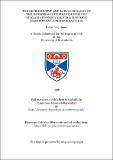Files in this item
The reproductive and larval ecology of the intertidal nudibranch mollusc 'Adalaria proxima' (Alder & Hancock) (Gastropoda : opisthobranchia)
Item metadata
| dc.contributor.advisor | Todd, Christopher David | |
| dc.contributor.author | Jones, Helen Lucy | |
| dc.coverage.spatial | 373 p. | en_US |
| dc.date.accessioned | 2018-06-26T15:18:47Z | |
| dc.date.available | 2018-06-26T15:18:47Z | |
| dc.date.issued | 1996 | |
| dc.identifier.uri | https://hdl.handle.net/10023/14633 | |
| dc.description.abstract | This study concerns the reproductive and larval ecology of the nudibranch Adalaria proxima. Attainment of competence is demonstrated to be cue specific. Embryos metamorphose in response to choline, yet remain precompetent to elevated potassium and the natural cue until after hatching. It is hypothesized that the choline-mediated metamorphic pathway (or choline-sensitive portion of the natural pathway) becomes functionally complete ontogenetically earlier than do larval chemoreceptors. Larvae metamorphose in response to sea water 'conditioned' (CSW) by the bryozoan Electra pilosa. A range of littoral organisms failed to induce metamorphosis and it is suggested that A. proxima displays a high degree of cue specificy. It is reported that CSW-mediated metamorphosis is dose dependent and effected in a disparate manner to that of potassium. No evidence for a bacterial role in metamorphosis was found. These results are intended to facilitate future isolation of the natural cue. Both starved (lecithotrophic) and fed (facultatively planktotrophic) larvae may successfully delay metamorphosis for 28-31d post-hatching (at 10-C). Larval fitness appeared to be unaffected by nutritional status, which is suggested to reflect the transitional evolutionary nature of facultative planktotrophy. The lowered fitness commensurate with an extended pelagic period is hypothesized to confer a lowered dispersal potential. A. proximais semelparous, producing up to eleven spawn before dying. Significant variation in reproductive traits is demonstrated within and between six U.K. populations of A. proxima Intrapopulation decreases in egg size, fecundity and hatching success with spawn laying sequence are suggested to reflect phylogenetic constraints. Interpopulation differences in egg size and fecundity are considered consistent with the predicted limited larval dispersal potential. Population egg size was correlated to larval size but not latitude or fecundity. Possible causative factors of the observed interpopulation variation in reproductive traits are discussed, and most probable causes hypothesized. | en_US |
| dc.language.iso | en | en_US |
| dc.publisher | University of St Andrews | |
| dc.subject.lcc | QL430.5A45J7 | en |
| dc.subject.lcsh | Gastropoda | en |
| dc.title | The reproductive and larval ecology of the intertidal nudibranch mollusc 'Adalaria proxima' (Alder & Hancock) (Gastropoda : opisthobranchia) | en_US |
| dc.type | Thesis | en_US |
| dc.contributor.sponsor | Natural Environment Research Council (NERC) | en_US |
| dc.type.qualificationlevel | Doctoral | en_US |
| dc.type.qualificationname | PhD Doctor of Philosophy | en_US |
| dc.publisher.institution | The University of St Andrews | en_US |
This item appears in the following Collection(s)
Items in the St Andrews Research Repository are protected by copyright, with all rights reserved, unless otherwise indicated.

